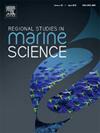The water physicochemical factors, plankton, and biological composition of Penaeus vannamei guts in the salt-field ponds
IF 2.1
4区 环境科学与生态学
Q3 ECOLOGY
引用次数: 0
Abstract
The shrimp farming in salt-field has attracted people’s attention due to the high quality of the shrimp being farmed. In this study, four salt-field ponds with salinity of 33 ± 5 (HS33), 40 ± 5 (HS40), 47 ± 5 (HS47), and 52 ± 7 (HS52) were selected and their water physicochemical factors, plankton, and gut food organism composition of shrimp (Penaeus vannamei) from May to September were analyzed. The results showed a time difference between the peak of nutrients and the peak of phytoplankton bloom in the water. Total nitrogen and phosphorus concentrations increased and then decreased, with peaks in July. Phytoplankton density increased and then decreased, with a peak in August. In contrast, the zooplankton densities in all groups decreased and then increased over time, with a minimum in June. Besides, diatoms are the main phytoplankton, and copepods and rotifers are the main zooplankton in salt-field ponds during the investigation period. The main phytoplankton in salt-field ponds are not affected by culture time. The zooplankton exhibited a decrease in average size from July to September due to the decrease in copepods and the increase in rotifers. In addition, phytoplankton density was not affected by the salinity gradient in the salt-field ponds, whereas zooplankton density increased with increasing salinity from 33 to 47, decreasing at 52 salinity. The plankton consumed by shrimp in all salt-field ponds is mainly dominated by green algae and copepods and is less affected by salinity and culture time, except in August. These results indicated that the plankton structure of the salt-field pond is reasonable and relatively stable. Zooplankton may be feeding selectively and act as mediators of green algae into the shrimp intestine. An appropriate increase in salinity (from 33 to 47) can enhance zooplankton abundance and is more suitable for the growth of shrimp. The results of this study will provide useful information for the development of shrimp farming in salt-fields.
求助全文
约1分钟内获得全文
求助全文
来源期刊

Regional Studies in Marine Science
Agricultural and Biological Sciences-Ecology, Evolution, Behavior and Systematics
CiteScore
3.90
自引率
4.80%
发文量
336
审稿时长
69 days
期刊介绍:
REGIONAL STUDIES IN MARINE SCIENCE will publish scientifically sound papers on regional aspects of maritime and marine resources in estuaries, coastal zones, continental shelf, the seas and oceans.
 求助内容:
求助内容: 应助结果提醒方式:
应助结果提醒方式:


